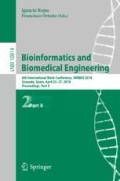Abstract
This work explores novel alternatives to conventional linear homotopy to enhance the quality of resulting transitions from object deformation applications. Studied/introduced approaches extend the linear mapping to other representations that provides smooth transitions when deforming objects while homotopy conditions are fulfilled. Such homotopy approaches are based on transcendental functions (TFH) in both simple and parametric versions. As well, we propose a variant of an existing quality indicator based on the ratio between the coefficients curve of resultant homotopy and that of a less-realistic, reference homotopy. Experimental results depict the effect of proposed TFH approaches regarding its usability and benefit for interpolating images formed by homotopic objects with smooth changes.
Access this chapter
Tax calculation will be finalised at checkout
Purchases are for personal use only
References
Alpala, L.O., Peluffo-Ordóñez, D.H., González-Castaño, C., Guasmayan, F.A.: Deforming objects via exponential homotopy: a first approach. In: 2015 20th Symposium on Signal Processing, Images and Computer Vision (STSIVA), pp. 1–6. IEEE (2015)
Riehl, E.: Categorical Homotopy Theory, vol. 24. Cambridge University Press, Cambridge (2014)
He, J.H.: Homotopy perturbation method: a new nonlinear analytical technique. Appl. Math. Comput. 135(1), 73–79 (2003)
Babolian, E., Azizi, A., Saeidian, J.: Some notes on using the homotopy perturbation method for solving time-dependent differential equations. Math. Comput. Modell. 50(1), 213–224 (2009)
Molina-Abril, H., Real, P.: A homological-based description of subdivided nD objects. In: Real, P., Diaz-Pernil, D., Molina-Abril, H., Berciano, A., Kropatsch, W. (eds.) CAIP 2011. LNCS, vol. 6854, pp. 42–50. Springer, Heidelberg (2011). https://doi.org/10.1007/978-3-642-23672-3_6
Peluffo-Ordóñez, D.H., Alvarado-Pérez, J.C., Lee, J.A., Verleysen, M., et al.: Geometrical homotopy for data visualization. In: European Symposium on Artificial Neural Networks, Computational Intelligence and Machine Learning (ESANN 2015) (2015)
Salazar-Castro, J., Rosas-Narváez, Y., Pantoja, A., Alvarado-Pérez, J.C., Peluffo-Ordóñez, D.H.: Interactive interface for efficient data visualization via a geometric approach. In: 2015 20th Symposium on Signal Processing, Images and Computer Vision (STSIVA), pp. 1–6. IEEE (2015)
Feng, X.: Geometric and topological modeling techniques for large and complex shapes. Michigan State University (2014)
Georghiades, A., Belhumeur, P., Kriegman, D.: Yale face database, vol. 2. Center for computational Vision and Control at Yale University (1997). http://cvc.yale.edu/projects/yalefaces/yalefa
Acknowledgments
This work is supported by the “Smart Data Analysis Systems - SDAS” group (http://sdas-group.com).
Author information
Authors and Affiliations
Corresponding author
Editor information
Editors and Affiliations
Rights and permissions
Copyright information
© 2018 Springer International Publishing AG, part of Springer Nature
About this paper
Cite this paper
Salazar-Castro, J.A. et al. (2018). Advances in Homotopy Applied to Object Deformation. In: Rojas, I., Ortuño, F. (eds) Bioinformatics and Biomedical Engineering. IWBBIO 2018. Lecture Notes in Computer Science(), vol 10814. Springer, Cham. https://doi.org/10.1007/978-3-319-78759-6_22
Download citation
DOI: https://doi.org/10.1007/978-3-319-78759-6_22
Published:
Publisher Name: Springer, Cham
Print ISBN: 978-3-319-78758-9
Online ISBN: 978-3-319-78759-6
eBook Packages: Computer ScienceComputer Science (R0)

